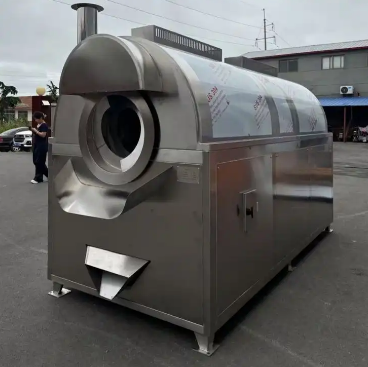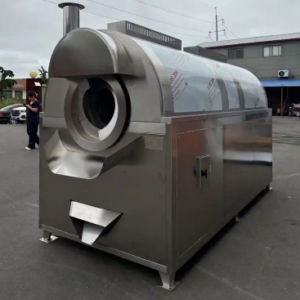<h1>Introducing the Electromagnetic Stir-Frying Machine: A Game-Changer in Food Processing</h1>What is an Electromagnetic Stir-Frying Machine?
An electromagnetic stir-frying machine is a modern industrial appliance designed to automate and enhance the stir-frying process in food production. It uses electromagnetic induction technology to generate heat directly in the cooking vessel, eliminating the need for traditional gas or electric burners. This innovation is particularly popular in B2B settings, such as food manufacturing plants and commercial kitchens.
Electromagnetic Stir-Frying Machine
ToggleUnlike conventional fryers, this machine integrates precise temperature control and automated stirring mechanisms. It ensures even cooking and reduces manual labor, making it ideal for businesses aiming to scale operations efficiently. Key components include a durable metal wok, electromagnetic coils, and advanced sensors for monitoring heat and motion.
In the foreign trade sector, these machines are exported globally for their energy efficiency and compliance with international safety standards. Manufacturers often customize them to meet specific regional needs, such as varying voltage requirements or material preferences.
How Does an Electromagnetic Stir-Frying Machine Work?
The core principle behind an electromagnetic stir-frying machine is electromagnetic induction. When an electric current passes through the coils in the base, it creates a magnetic field that induces heat directly in the ferromagnetic wok. This process is rapid and highly efficient, reaching desired temperatures in seconds.
Once activated, the machine’s built-in stirrer rotates automatically, ensuring ingredients are evenly mixed and cooked. Sensors monitor the cooking environment, adjusting heat and speed based on preset programs. This automation minimizes the risk of overcooking or burning, which is a common issue in manual stir-frying.
For B2B users, this technology translates to consistent product quality and reduced waste. Businesses can program the machine for different recipes, making it versatile for processing nuts, seeds, snacks, or even meat products. Integration with smart systems allows remote monitoring, enhancing productivity in large-scale operations.
Key Benefits for Businesses in Foreign Trade
Electromagnetic stir-frying machines offer numerous advantages that appeal to B2B clients in the food industry. First, they boast superior energy efficiency, consuming up to 30% less power than gas-based alternatives. This leads to lower operational costs and a smaller carbon footprint, aligning with global sustainability goals.
Another benefit is enhanced safety. Without open flames, the risk of fires or gas leaks is eliminated, making these machines suitable for high-volume production environments. They also feature automatic shut-off mechanisms, reducing accidents and ensuring compliance with international safety regulations.
From a productivity standpoint, these machines can process larger batches quickly, boosting output for exporters. For instance, a single unit might handle 50-100 kg of product per hour, depending on the model. This scalability helps businesses meet growing demands in markets like Asia, Europe, and North America.
Applications Across Various Industries
In the food processing industry, electromagnetic stir-frying machines are widely used for producing fried nuts, beans, and snacks. Their precise control ensures optimal texture and flavor, which is crucial for maintaining product standards in export markets. Companies specializing in healthy snacks often rely on this technology to minimize oil usage.
Beyond snacks, these machines find applications in the pharmaceutical sector for processing herbal medicines or extracts. The even heating prevents degradation of sensitive ingredients, making them valuable for B2B suppliers in health and wellness. In the hospitality industry, they support large-scale catering by streamlining kitchen operations.
For foreign trade businesses, these machines enable customization for international clients. For example, exporters can adapt them for different voltage systems or add features like multilingual interfaces. This versatility opens doors to diverse markets, from small-scale importers to multinational corporations.
Case Studies: Real-World Implementation
One notable example is a Chinese manufacturer that exported electromagnetic stir-frying machines to European snack producers. The machines helped reduce energy costs by 25% while improving product consistency. In another case, an American food company integrated these devices into their line for organic nut roasting, enhancing market competitiveness.
These success stories highlight how the technology adapts to specific industry needs. Businesses in emerging markets, such as Southeast Asia, use them for local delicacies, while Western firms leverage them for premium health foods. The adaptability drives demand in global trade exhibitions and online B2B platforms.
Comparing Electromagnetic Stir-Frying Machines to Traditional Methods
When compared to traditional stir-frying methods, such as gas-fired woks, electromagnetic models stand out for their precision and efficiency. Traditional systems often require constant manual stirring and are prone to uneven heating, leading to inconsistent results and higher labor costs.
Electromagnetic versions, however, provide uniform heat distribution, which preserves nutrients and enhances flavor profiles. They also generate less smoke and emissions, improving workplace conditions and meeting environmental regulations in export destinations. This makes them a smarter choice for businesses focused on sustainability.
In terms of cost, while the initial investment may be higher, the long-term savings on energy and maintenance make electromagnetic machines more economical. B2B buyers often factor in these aspects during procurement, especially when sourcing from foreign suppliers. Overall, the technology represents a clear upgrade for modern food processing workflows.
Selecting and Maintaining Your Electromagnetic Stir-Frying Machine
Choosing the right electromagnetic stir-frying machine involves assessing your business needs, such as capacity and automation level. Look for models with adjustable settings and durable materials like stainless steel to ensure longevity in demanding environments. Reputable foreign trade suppliers often provide detailed specifications and certifications.
Maintenance is straightforward but essential for optimal performance. Regular cleaning of the wok and coils prevents residue buildup, which can affect efficiency. Businesses should schedule routine checks on sensors and motors, ideally every three months, to avoid downtime.
For B2B users, partnering with manufacturers that offer warranty and after-sales support is key. This includes access to spare parts and training programs, ensuring seamless integration into existing production lines. Proper maintenance extends the machine’s lifespan, potentially up to 10 years with good care.
Tips for Efficient Operation
To maximize benefits, always follow the manufacturer’s guidelines for loading ingredients and setting temperatures. Use high-quality oils to prevent corrosion and monitor usage logs for predictive maintenance. Integrating these machines with ERP systems can further streamline B2B operations.
Additionally, train staff on safety protocols to leverage the machine’s features fully. This not only boosts productivity but also minimizes errors, making it a reliable asset in competitive markets.
Frequently Asked Questions
Below, we address some common queries from businesses considering electromagnetic stir-frying machines.
What is the energy consumption of an electromagnetic stir-frying machine?
These machines typically use 20-50% less energy than traditional models, depending on usage. Factors like batch size and heat settings influence this, making them cost-effective for high-volume B2B applications.
How does it ensure food safety during processing?
Built-in sensors monitor temperatures to prevent overheating, while automated stirring reduces contamination risks. This complies with standards like HACCP, which is vital for exporters.
Can it be customized for specific ingredients?
Yes, many models allow programmable settings for different foods, such as nuts or spices. Manufacturers offer B2B customization options to tailor the machine to your product line.
What is the average lifespan of these machines?
With proper maintenance, they can last 8-12 years. Regular upkeep and quality components from reliable suppliers ensure long-term reliability in industrial settings.
Are they suitable for small businesses?
Absolutely, compact models are available for startups, while larger units scale with growth. This flexibility makes them accessible for B2B entrants in the food trade.
Conclusion
In summary, the electromagnetic stir-frying machine represents a significant advancement in food processing technology, offering efficiency, safety, and versatility for B2B operations. By adopting this innovation, businesses can enhance productivity, reduce costs, and meet global market demands while prioritizing sustainability. Whether you’re an exporter or manufacturer, investing in this equipment can drive long-term success in the competitive world of foreign trade.








